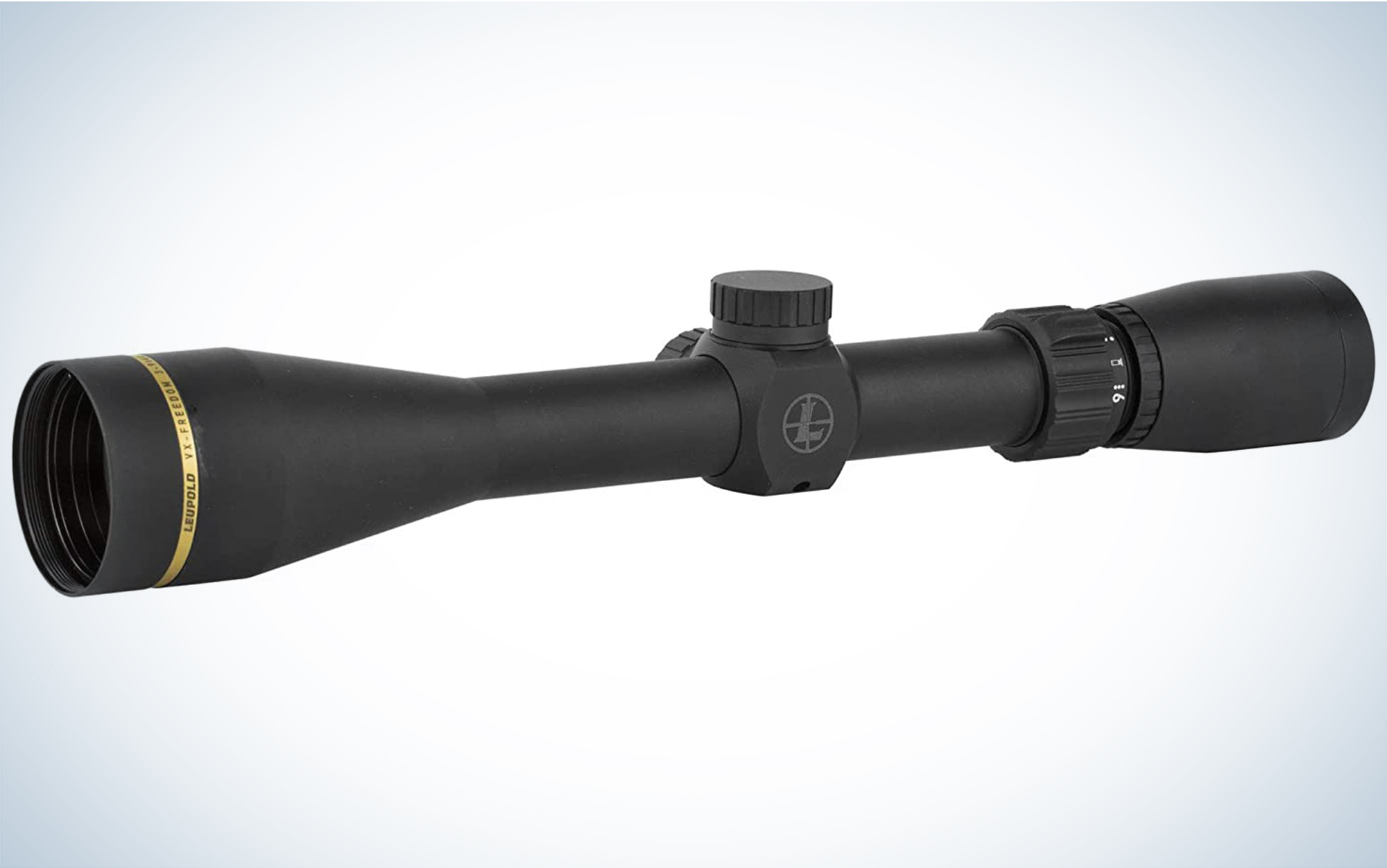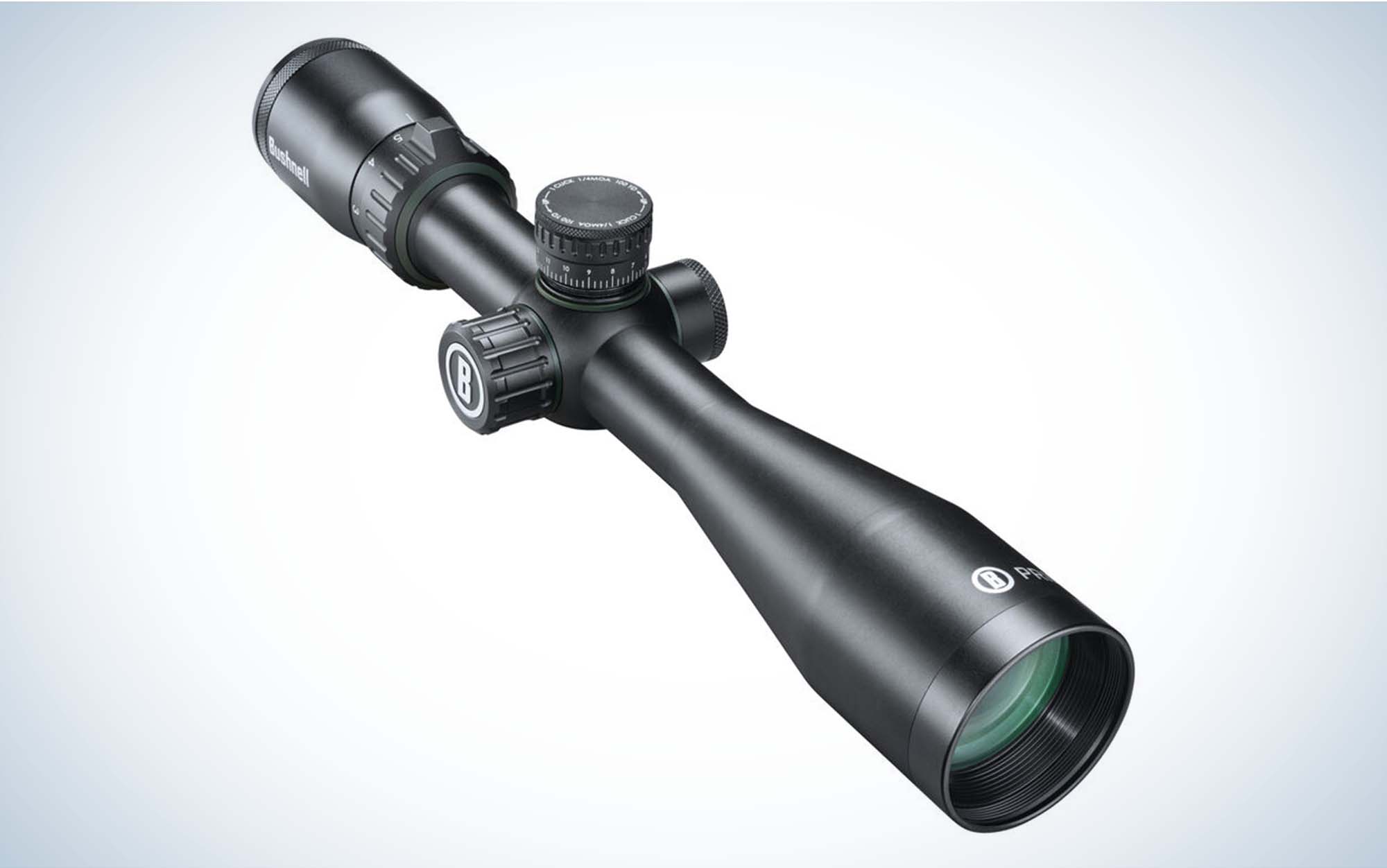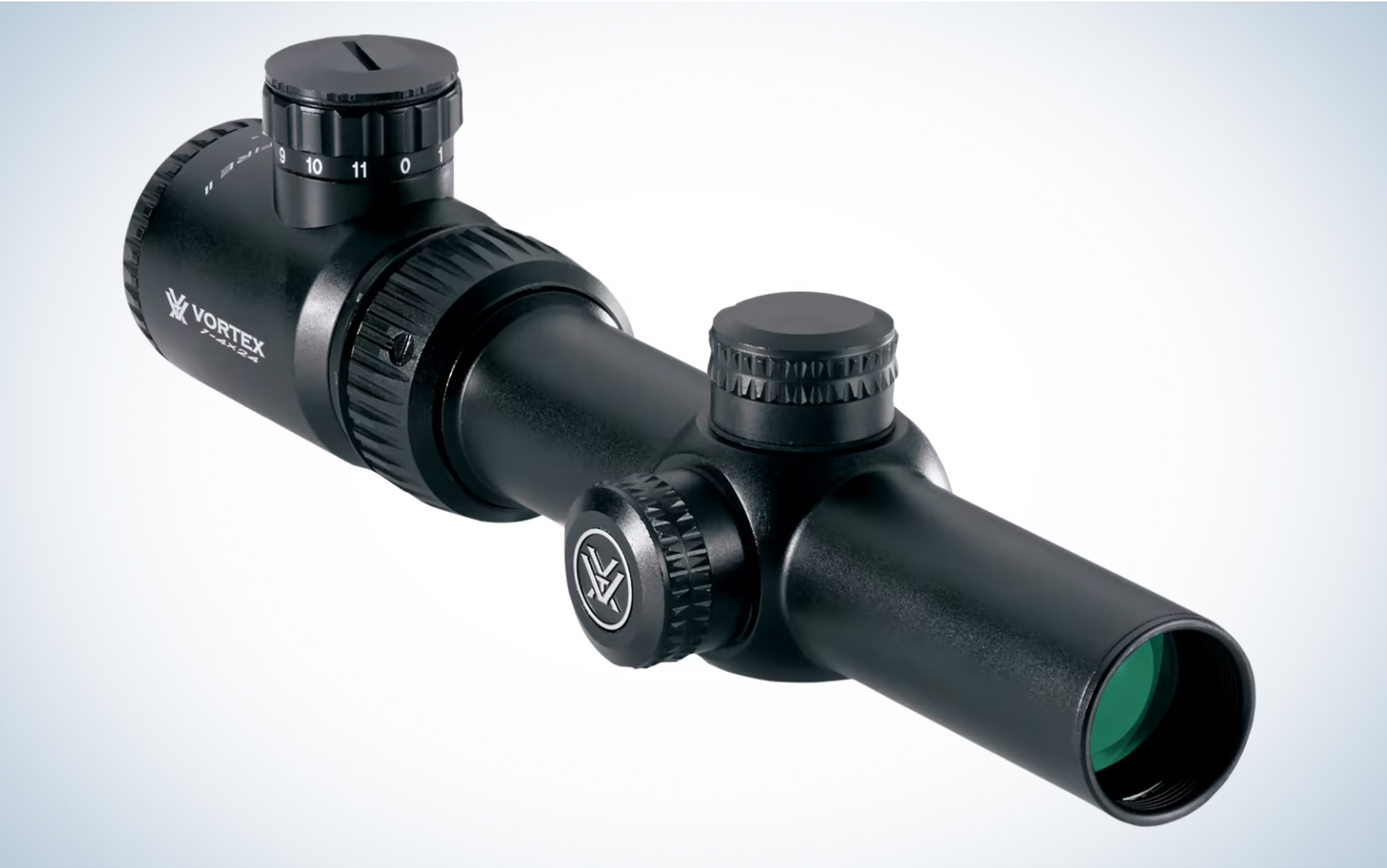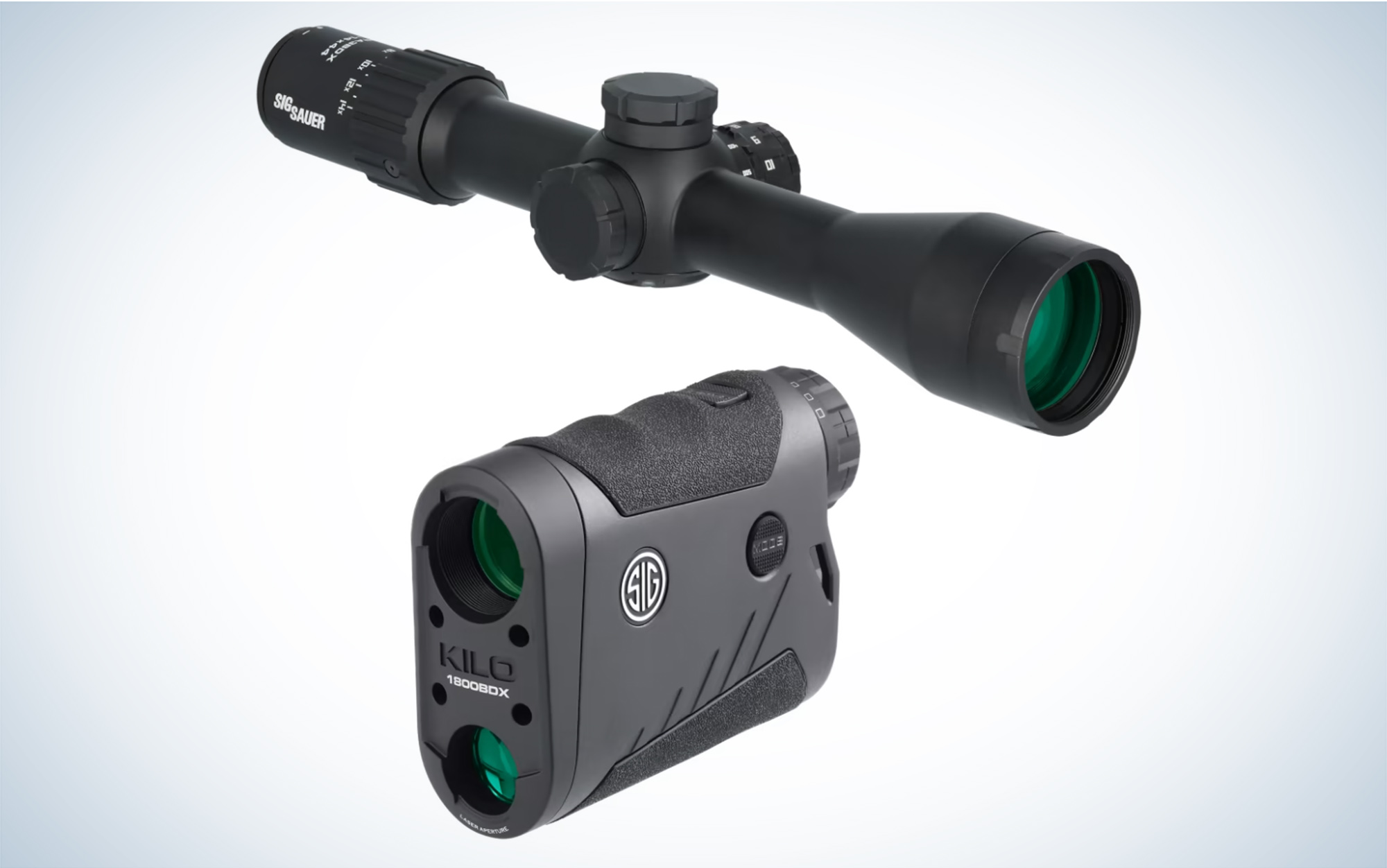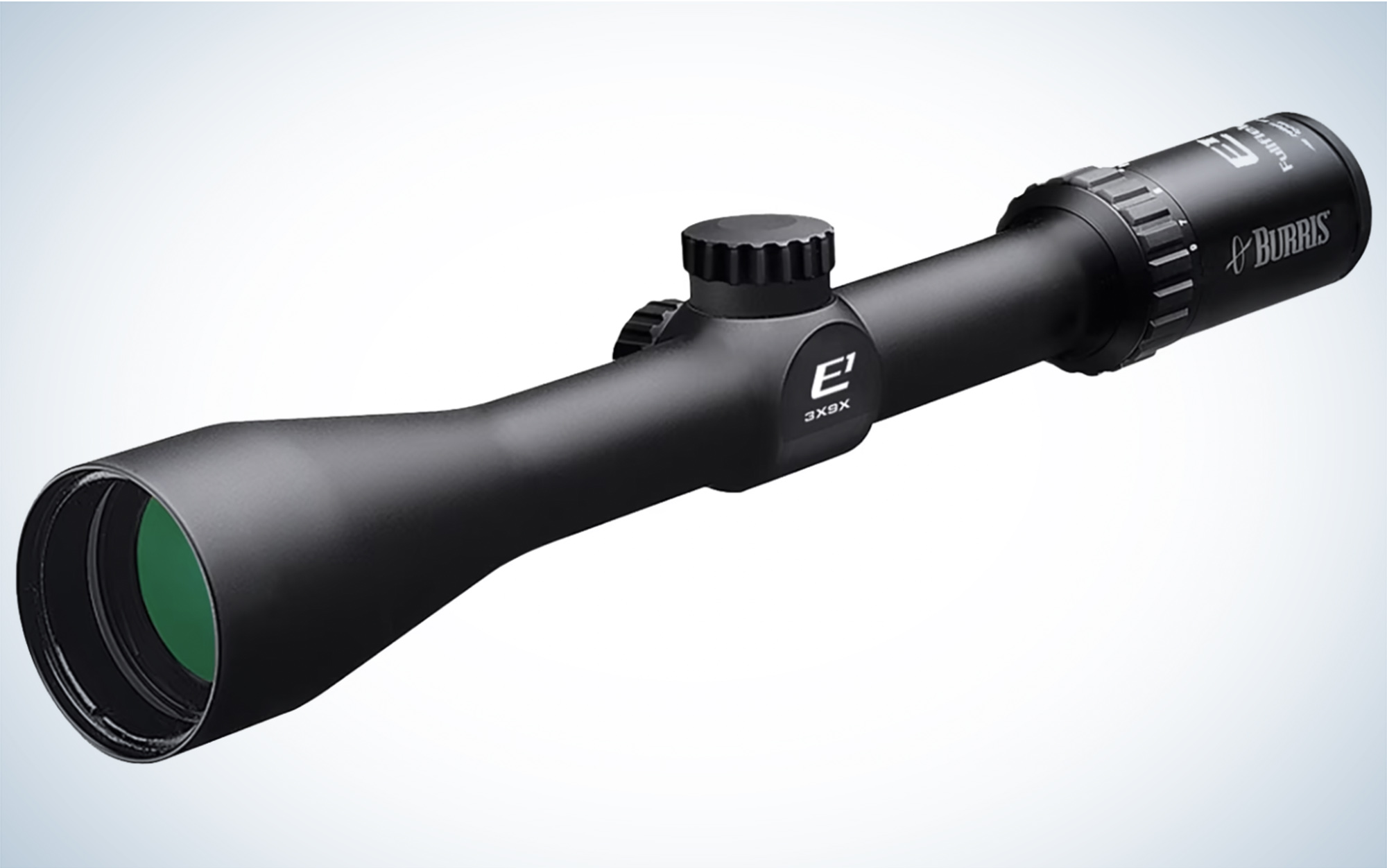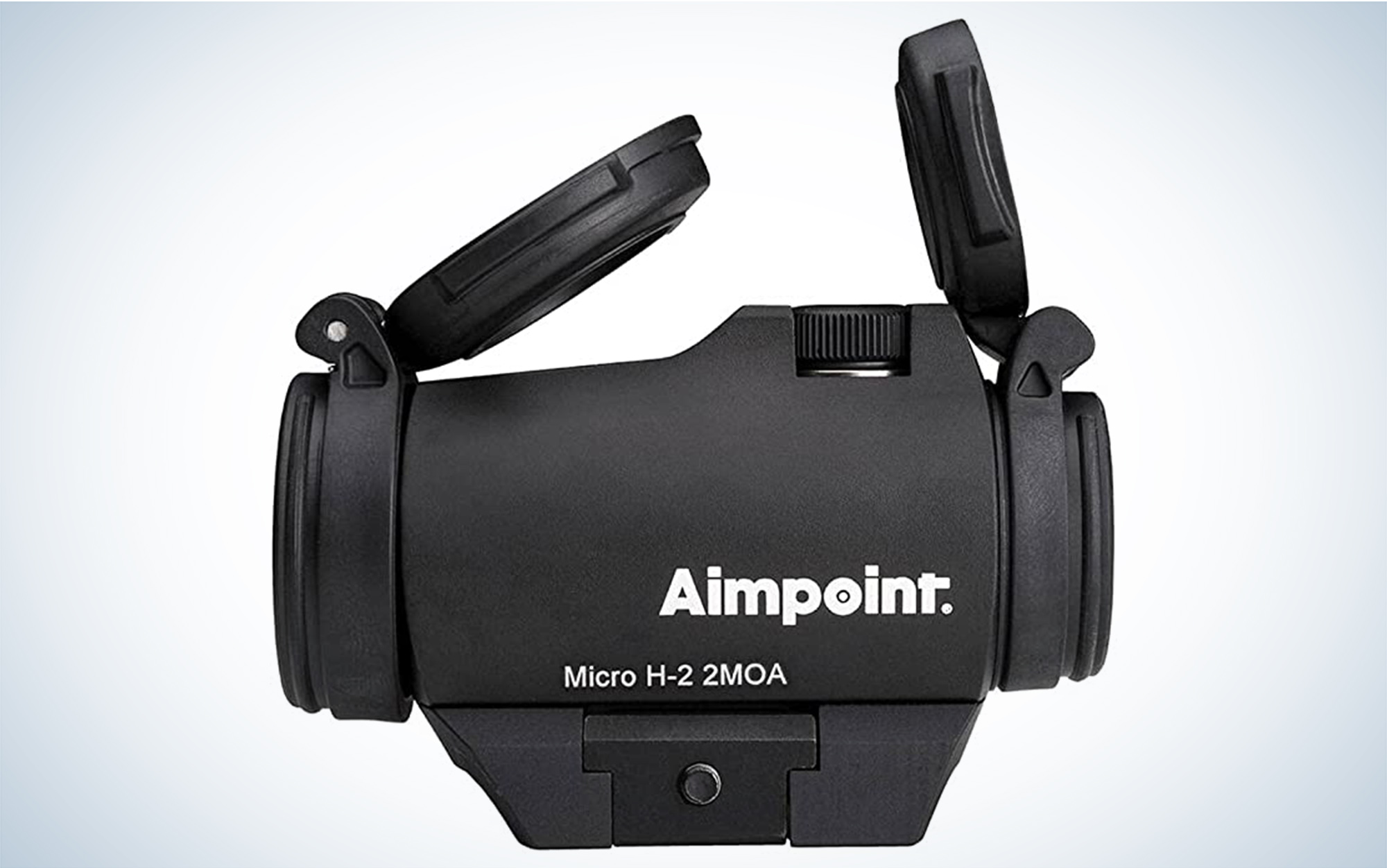We may earn revenue from the products available on this page and participate in affiliate programs. Learn More ›
Updated Sep 22, 2023 12:19 PM
Muzzleloaders have changed drastically since 1985 when Tony Knight released the modern inline rifle, and so have muzzeloader scopes. It was the start of a technological race to build a better mousetrap and garnered the attention for a new generation of front stuffers. Reliability and accuracy have increased to the point that some modern muzzleloaders can outperform some .30 caliber centerfire rifles. In most cases, the muzzleloaders are more accurate than many realize.
During the same time, optics and rifle scopes have advanced to provide clear advantages with great glass and turrets and reticles calibrated to specific loads. Some scopes even range a target or get ballistic data by connecting to a smartphone. To help you choose among these great scopes, I spent time looking through and shooting several of the best muzzleloader scopes. Here are my top picks for the modern muzzleloader hunter.
How I Chose the Best Muzzleloader Scopes
I used my experience shooting and hunting with muzzleloaders throughout the country to evaluate muzzleloader scopes based on the following characteristics:
- Glass quality (Is the scope clear with good low-light performance?)
- Reticle (Is the reticle intuitive and ideal for muzzleloader hunting?)
- Turrets (Do the turrets have tactile clicks and easy to read?)
- Durability (Can the scope withstand hard knocks and recoil?)
Best Muzzleloader Scopes: Reviews and Recommendations
Best Overall: Leupold VX-Freedom UltimateSlam
Key Features
- Magnification: 3 to 9 power
- Objective lens: 40 millimeter
- UltimateSlam reticle
- Second focal plane
- Adjustments: .25 MOA
- Weight: 12.2 ounces
Pros
- Aiming points can be calibrated for specific powder and bullet combinations
- Versatile
- Not caliber specific
Cons
- Second focal plane
- Calibrated for 100- and 150-grain loads
Leupold’s VX-Freedom with the UltimateSlam reticle is a second focal plane scope, so the magnification setting does affect the BDC reticle’s point of impact. For most muzzleloaders, hunters using the maximum loads of 150 grains will simply set the scope to maximum power. Leupold makes it easy with markers on the power adjustment ring, which indicate two or three pellet loads. The shooter adjusts the power setting to the load indicating 100 or 150 grains of powder.
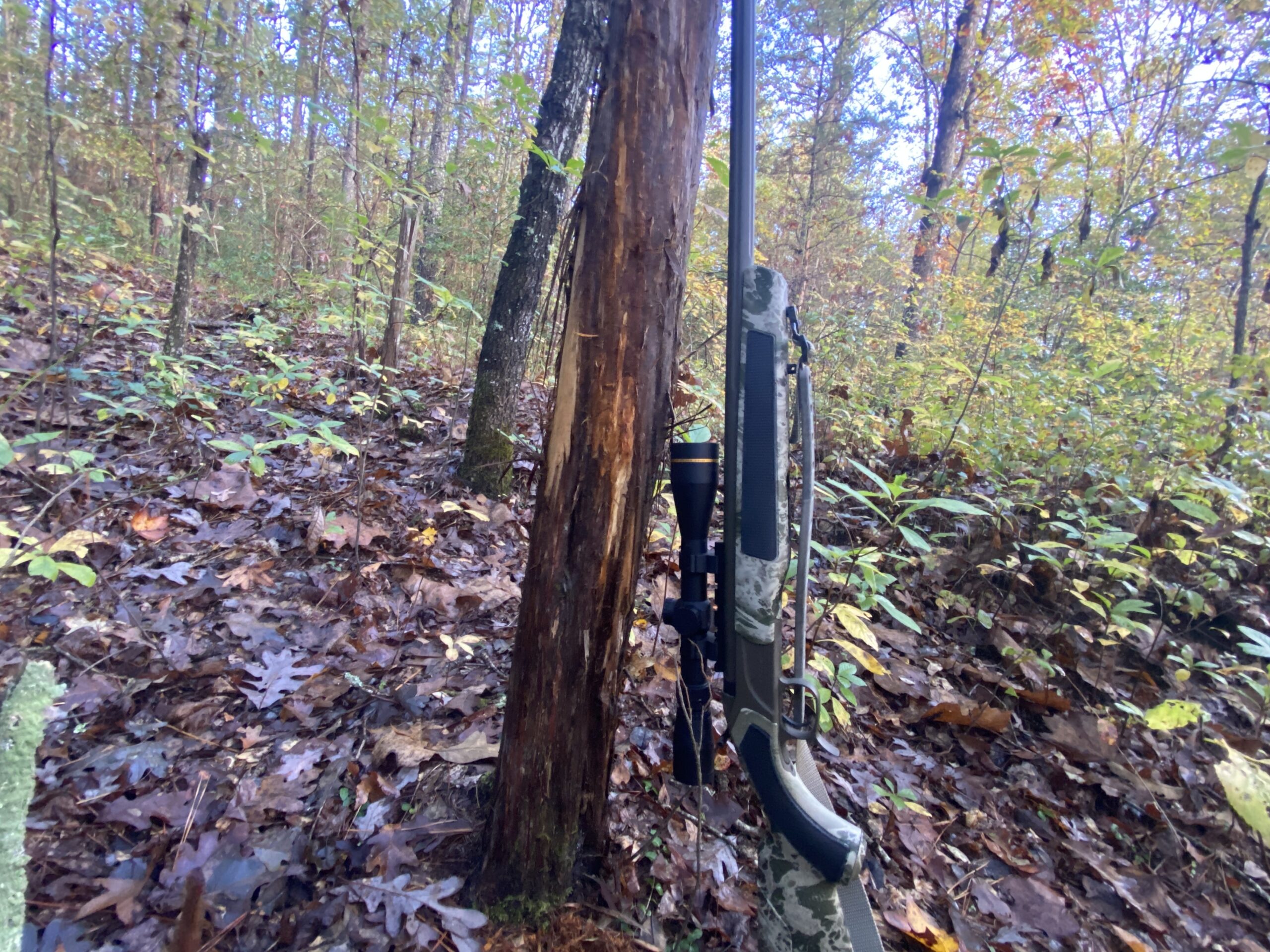
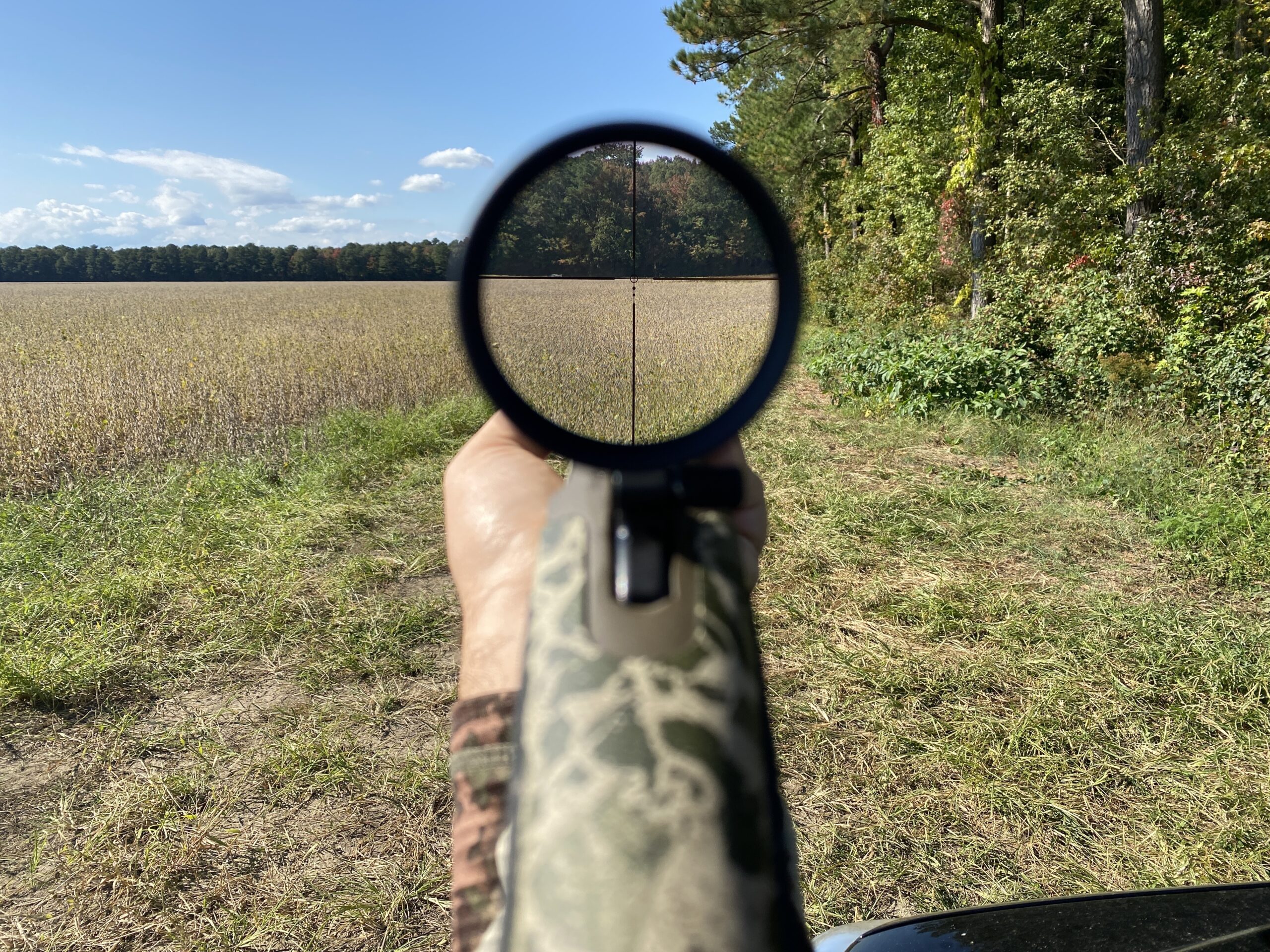
With a 100-yard zero the reticle provides aiming points out to 300 yards. The scope is intuitive to use while hunting once the user dials in their preferred loads.
Leupold glass provides a crisp, clear image even in low light conditions. The scratch-resistant lenses are great for people that tend to be hard on gear. The focus for the reticle requires little movement to find a perfect image. The power magnification dial requires firm pressure to move but is ridged and has a thumb catch for intuitive adjustments.
Best Ballistically Calibrated Turrets: Bushnell Prime 3-12X40 Riflescope Multi Turret
Key Features
- Includes seven turrets for different ballistic profiles
- 3 to 12 power
- Weight: 20 ounces
- Exo Barrier coating repels water
- Ultra-wide band coatings on the lenses increase dusk and dawn light waves for clear images while reducing glare
- Includes: MOA turret, 350-grain three-pellet turret, 250 grain 3 pellet turret (12 guage), 250 grain 2 pellet turret (20 gauge), 450 Bushmaster turret, 22 LR turret, .17 HMR turret, and elevation turret cap
Pros
- Compact and lightweight
- Magnification allows for accuracy at any distance
- Calibrated out to 300 yards
Cons
- Larger than most muzzleloader optics
- No illumination
In the heat of the moment, remembering that you have to dial 4.5 MOA for your 220-yard shot is a challenge if you haven’t practiced a lot. But, dialing to 220 yards for a 220-yard shot is much more intuitive. That’s the appeal of ballistically calibrated turrets, and as muzzleloaders can stretch their effective range beyond 100 yards, more hunters want that capability.
Bushnell offers seven turrets with its Prime 3-12X40 Riflescope Multi Turret, including three for muzzleloaders. The turret for lighter charges maxes out at 250 yards, and the magnum turrets max out at 300 yards.
The Prime 3-12X40 Riflescope Multi Turret is a lightweight, compact design weighing only 17 ounces. The 40 mm objective lens offers plenty of light-gathering for the first and last hour of shooting light. The 3.5 inches of eye relief means muzzleloaders using extreme charges have a reduced chance of generating scope bite. There isn’t a big throw lever to adjust power, but a ribbed knurl is easy to find with your thumb to adjust while looking through the scope.
Key Features
- Magnification: 4 to 16 power
- Objective Lens: 50mm
- Second focal plane
- Adjustments: .125 MOA
- Weight: 20 ounces
Pros
- Exo Barrier coating repels water
- Turrets and ballistic data used for long-range accuracy
- Lightweight (20 ounces) for its size
- Plenty of magnification
Cons
- Larger than most muzzleloader optics
- Reticle does not offer aiming points
The Elite 4500 offers a big eyebox and 4.4 inches of eye relief, which is ideal for muzzleloaders with lots of bark and recoil. This scope’s clarity and light transmission also make it ideal for locating targets or game at long distances.
Bushnell’s Elite 4500 is clear from edge to edge, and its 50 mm objective lens offers plenty of light-gathering. The Elite 4500 can stand up to severe recoil for those that live by the mantra that more powder and bigger bullets are the best. The turrets are secure with low-profile caps that can easily be removed for quick adjustments. Bushnell’s heavy Multi-X post can be calibrated for elevation and windage. The Elite 4500 is also available in a 1-4×24 with Multi-X reticle and 2.5-10X40.
I pulled this optic off a .300 Win. Mag. to shoot on a .50 caliber inline muzzleloader, without skipping a beat. The versatility and visibility made finding the target and fine tuning an aiming point easy. The reticle is easy to focus with plenty of adjustment to make the image crisp.
Key Features
- Magnification: 1 to 4 power
- Objective Lens: 24mm
- Adjustments: .5 MOA
- 30mm tube
- V-Plex reticle with illuminated center dot
- Weight: 14.8 ounces
Pros
- 30 mm tube gathers light
- Compact
- Finger adjustable turrets
Cons
- No high-end zoom for long range
- 24 mm objective for light transmission
Low power and lightweight scopes were a theme in this year’s best rifle scope test, and the Vortex Crossfire II has many of the qualities of a great LPVO for hunting.
The coatings provide incredible light transmission and anti-reflective qualities. The 24 mm objective lens looks small but delivers big. The first thing that caught my attention was how quickly the target was acquired. The rifle scope offers 1 to 4 power, making it a versatile scope for standard inline muzzleloaders, especially treestand or blind hunters. Exceptionally clear, this fully multi-coated optic has excellent light transmission.
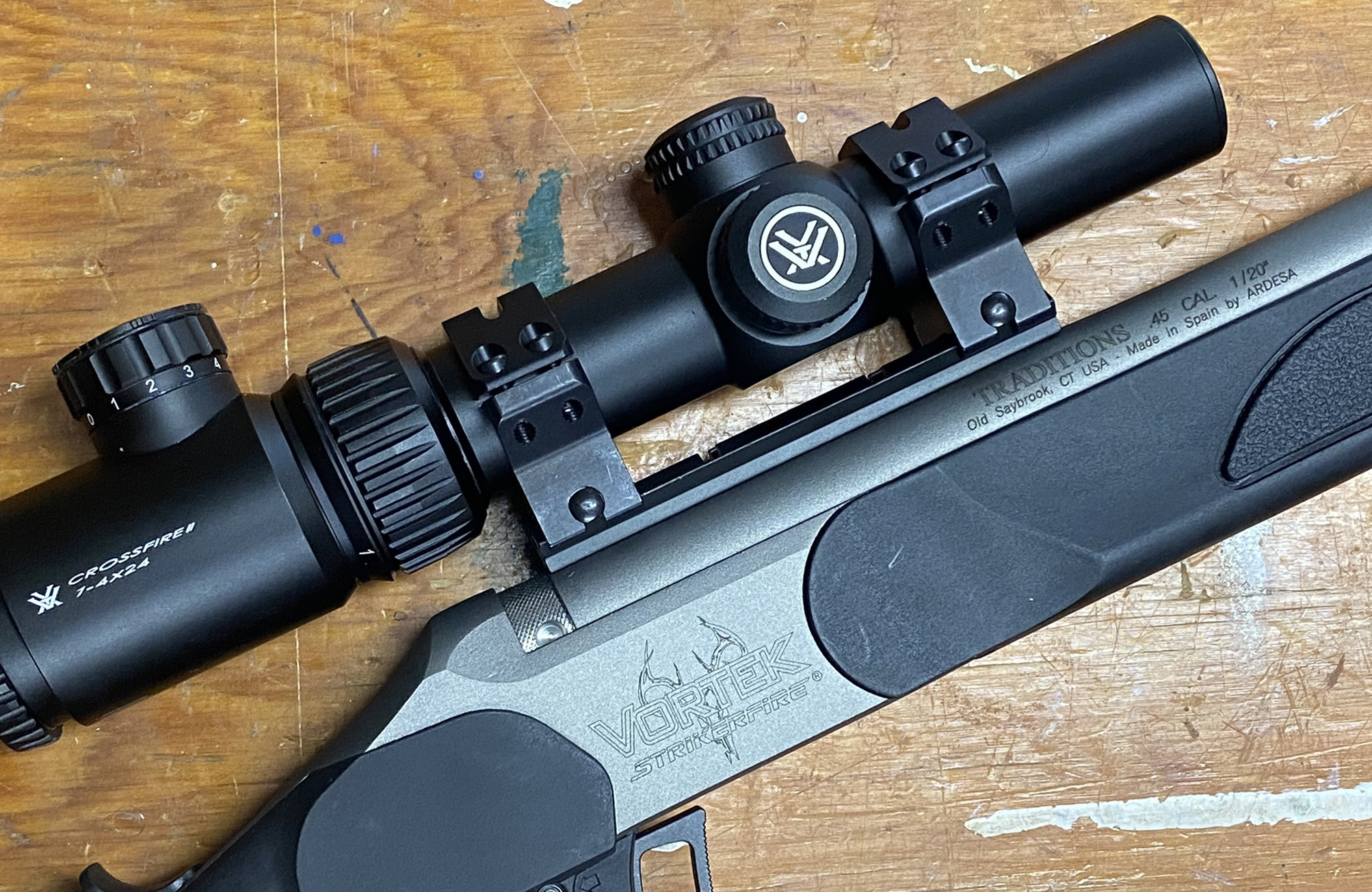
The Crossfire II is an excellent scope for a muzzleloader at 9.61 inches in length and a total weight of 14.8 ounces. It has a forgiving 4 inches of eye relief, making it easy to lift and find the target.
The Vortex V-Plex reticle is illuminated with a battery. The bright center dot makes it easier to acquire and hold on target. The bright dot is helpful for tired, aging eyes or for individuals with sight challenges, as well as a great training tool for holding a rifle still while engaging the trigger, as you can see any movement. The illumination is also beneficial in low-light conditions and in challenging environments. The magnification ring is challenging to find and move while looking through the optic. However, with the low magnification, adjustment is not likely required.
The scope turret adjustments are ½ MOA with 100 MOA of elevation and windage. Turrets are finger adjustable, and when sighted in, just pull the screw, rotate back to zero, and always know your sight-in distance. Using a MOA ballistic calculator to use the turrets for any caliber or powder and projectile load is easy. The second focal plane reticle maintains the same size and appearance.
Best Precision: Sig Sauer SIERRA3BDX 4.5-14X42mm
Key Features
- Bluetooth connectivity
- Precise hold illuminates on the reticle
- Instant data exchange for any range and hold point
- Can add different profiles for different loads
- Electronic level in the reticle
- Weight: 24.9 ounces
- 4.5 to 14 power
Pros
- Bluetooth connectivity
- Precise hold illuminates on the reticle
- Instant data exchange for any range and hold point
- Can add different profiles for different loads
- Electronic level in the reticle
Cons
- Heavy
- Requires rangefinder to use calibration in scope
Sig Sauer Electro-Optics Ballistic Data Exchange (BDX) rangefinder and rifle scope system make shooting accurately at any distance easy. The “SIG BDX” app pairs information from a KILO BDX rangefinder and transmits it to a BDX-enabled rifle scope. A blue LED on the rifle scope power selector indicates that the BDX system is paired and when the reticle has received new ballistic holdover and windage data from the rangefinder. “Applied Ballistics Ultralight” sends your ballistic information to the scope via Bluetooth for an illuminated dead-on reticle aim point.
The Sig BDX system is available in several rifle scope models, including the SIERRA and a Buckmasters combo. Ballistic information for any muzzleloader and load can be plugged into the app to get specific dope for precision shooting at any range. Shooting with the system was fun and exciting, with repeatable and accurate results. You can even set up different profiles to shoot different bullets and powders.
To use a BDX-enabled rifle scope, a hunter first ranges the target. The information is sent from the rangefinder to the scope and a holdover appears as a lighted dot inside the scope. If you want to dial, the system also tells you how many MOA or mils to dial the scope.
The turrets are well-marked and easy to turn. I found all of the knobs and dials to be user-friendly. The magnification ring stands out with the illuminated blue light when the scope is using Bluetooth. The power magnification ring is easy to move fluidly with a thumb catch.
Key Features
- Steel-on-steel knob construction
- Bullet-drop compensation reticle
- Wide field of view
- 3 to 9 power
- Forever warranty
- Weight: 13 ounces
Pros
- Steel-on-steel knob construction
- Bullet-drop compensation reticle
- Wide field of view
- Forever warranty
- Value priced
Cons
- Reticle information hard to read
The Burris Fullfield E1 costs around $240 and offers a field of view of 13 feet at 100 yards on high power. This 3 to 9 power is perfect for close to mid-range hunting where the muzzleloader platform excels. The reticles have been fine-tuned for added accuracy. The power zoom ring was updated to make adjusting easier while keeping the lens covers from turning. Hunters who still prefer a classic 3 to 9 power optic will find the Fullfield E1 versatile for any smokepole application.
You can execute long-range shots out to extended ranges with windage holds on blustery days. The Ballistic Plex E1 reticle is simple to use with trajectory-compensating technology and cascading dots to compensate for wind drift. The rifle scope design ensures components stand up to rugged use and recoil from magnum charges. The Burris Forever Warranty protects it.
Best for Quick Target Acquisition: Aimpoint Micro H-2
Key Features
- Fast target acquisition
- If you can see the red dot, you can shoot
- Compact and lightweight
- No issues with eye relief
- Fast sight-in
- Weight: 3.3 ounces (sight only)
Pros
- Fast target acquisition
- If you can see the red dot, you can shoot
- Compact and lightweight
- No issues with eye relief
Cons
- Dot covers the target at longer ranges
- Requires battery to operate
I used an Aimpoint sight on a South Dakota deer hunt and it proved effective to 150 yards. The sight can be easily mounted on a Picatinny rail mounting system. The Aimpoint Micro H-2 could be the perfect tool for anyone having trouble centering a scope on target. It can also be great for people with vision problems, but the bottom line is that you will not know the advantages until you try one. Seeing is believing, and optics are all about clarity and increasing accuracy.
Things to Consider When Buying a Muzzleloader
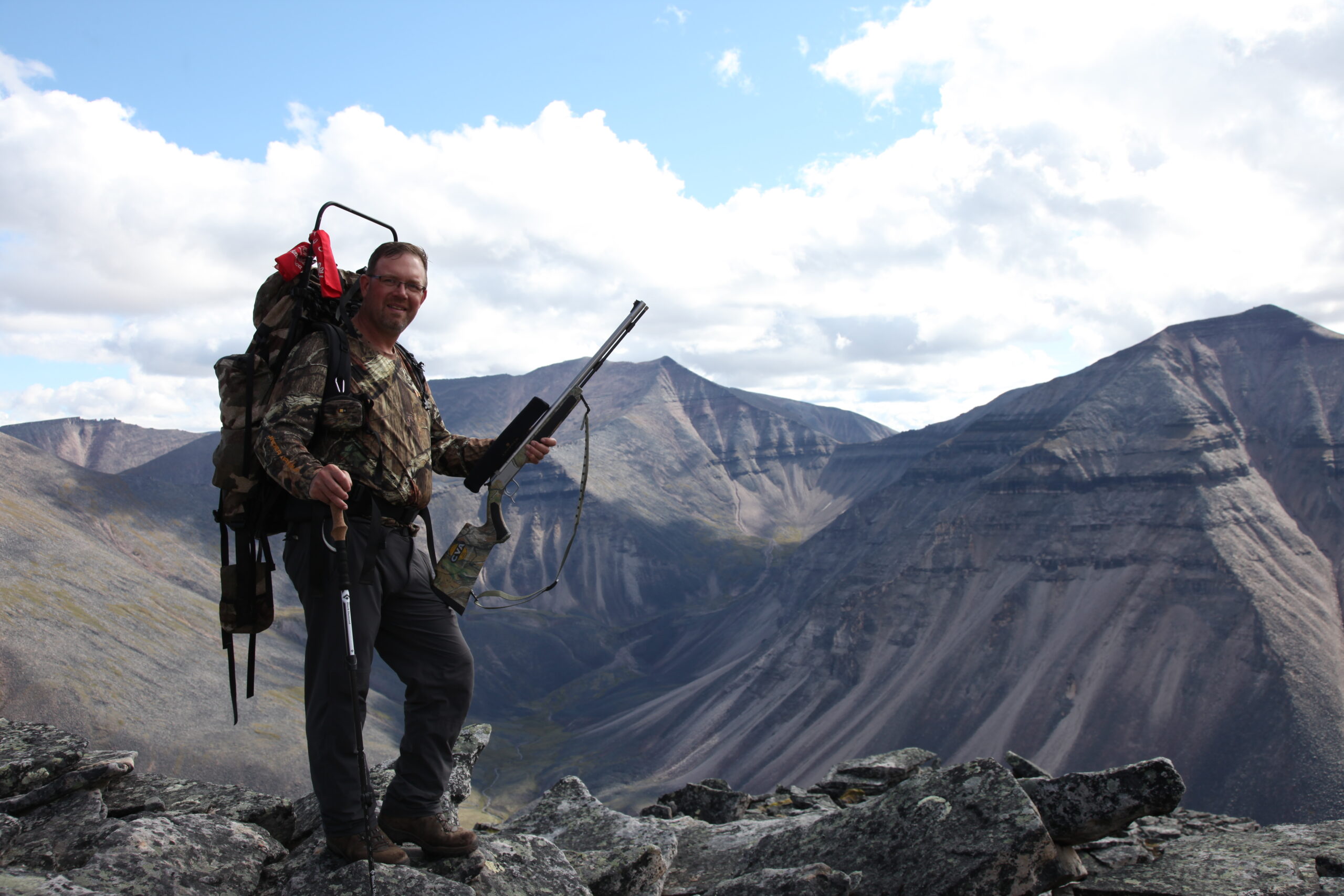
How much does a good muzzleloader scope cost?
Muzzleloader optics can range from less than $200 to $2,000. The Vortex and Burris scopes offer incredible value with reticles to enhance accuracy. The Sig Sierra is $760 and requires a Kilo rangefinder of $355+ to use all functions.
Are expensive optics worth the money?
Today’s muzzleloaders are incredibly accurate, and quality optics are the best way to maximize performance. A good optic will allow you to get the most out of a firearm and see its potential for accuracy. Long-range muzzleloaders will require matching optics to obtain results.
What should I look for in a muzzleloader scope?
With the top names in the optic industry offering muzzleloader rifle scopes and optics, it can be tough to decide on the right product. They offer waterproof, fog proof, multi-coated lenses with outstanding light transmission. They come with excellent warranties and different models and configurations. To make an informed decision, it is essential to check out the different scopes and look at the reticles firsthand. Some will seem natural, while others could be confusing. Be sure to dial the power adjustment ring to the maximum or to the power needed to line up the holdover points in each scope. Look at objects to the distances you intend to shoot while hunting and see if the reticle is clear. It provides good target visibility and lets the shooter quickly and confidently know what aiming point to use when seconds count. Use it in low light and see if the light transmission is sufficient, and try to fog up the lens with steam or even your breath.
FAQs
Q: What’s the difference between a muzzleloader scope and a rifle scope?
A scope specifically designed for an inline muzzleloader will have advantages over a standard rifle scope. A ballistically calibrated reticle for standard blackpowder loads can provide point of impact marks or holds out to 200 yards at 50-yard intervals. Some will even provide references beyond 200 yards. Most muzzleloader scopes will also provide extended eye relief for quick target acquisition and to help prevent scope bite. Turrets can be calibrated to muzzleloader loads to compensate for elevation and windage.
Q: Is an inline muzzleloader considered a firearm?
In short, muzzleloaders can be shipped to your door without having to go through an FFL (state and city regulations might affect that).
The long answer is Section 921(3) of the “Gun Control Act of 1968” says a firearm is “any weapon which will or is designed to or may readily be converted to expel a projectile by the action of an explosive; the frame or receiver of any such weapon; any firearm muffler or firearm silencer; or any destructive device. Such term does not include an antique firearm.”
Here’s the catch; modern muzzleloaders are classified as “antique firearms” as they are replicas of pre-20th Century designs and have limitations.
Q: What does BDC stand for?
BDC stands for “bullet drop compensator” built into the crosshair of a scope. The horizontal lines or dots on the vertical crosshair are set to envisage how much a bullet will drop at a given range. In most cases, the horizontal references are based on a 100-yard zero, then 50-yard increments as you move down to each line. Most BDC reticles offer three or four reference lines to shoot 250 to 300 yards.
Q: Is muzzleloader recoil too much for a scope?
Muzzleloader recoil differs from a centerfire rifle. Blackpowder burns slower, creating a longer recoil or push. A Centerfire cartridge with modern, smokeless powders burns fast, creating a fast punching recoil. Modern rifle scopes are designed to withstand recoil, even from magnum charges.
Final Thoughts
Muzzleloader enthusiasts have many options to place a bullet downrange with surgical accuracy. Knowing the best muzzleloader scopes helps provide perspective to find the perfect optic in your price range.

